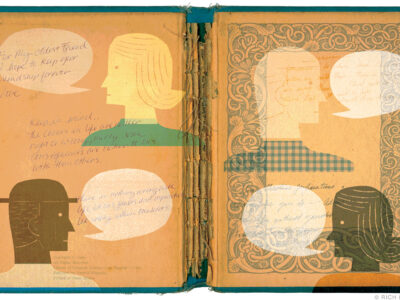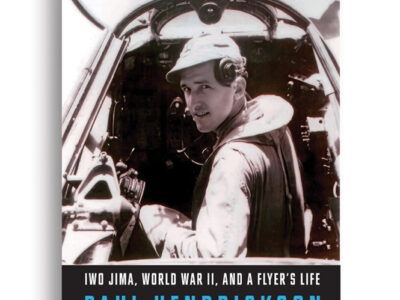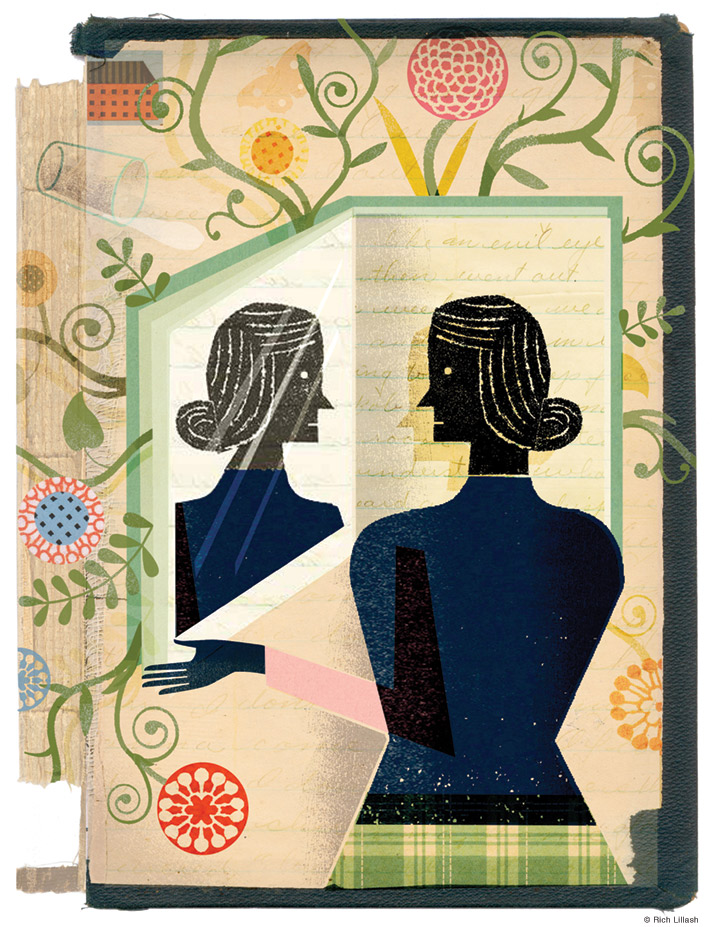
Middle school memories. Meditations on motherhood. A prismatic accounting of the self. A long life well and furiously lived.
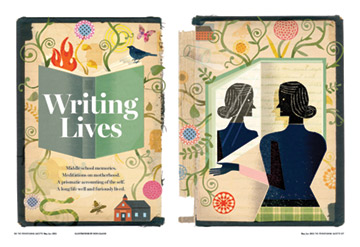
It so happened that in recent months we received copies of new memoirs by four accomplished alumni writers—Jordan Sonnenblick C’91, Courtney Zoffness C’00, Beth Kephart C’82, and Nick Lyons W’53—all remarkable in their own way, and with remarkably different approaches. Their arrival, via the Gazette’s inbox or mailing address, came in close enough succession for coincidence to seem something like fate, so we decided to put them together for this feature.—Ed.
Coming of Age
The year of being nine.
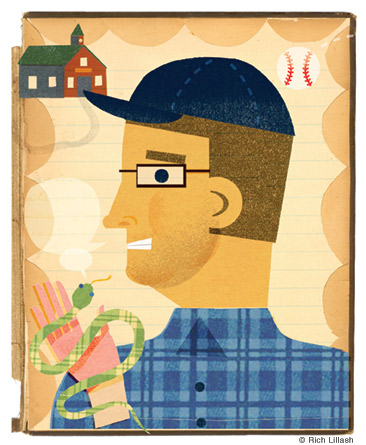
Not every writer has a life worthy of a full-length memoir—and even fewer would try to make a whole book out of one year in elementary school, assuming they even remembered it.
That’s probably why, when he thought back to his troubles in school, the young adult (YA) fiction writer Jordan Sonnenblick C’91, who is also a former English teacher, initially planned to write a book for adults about how his experiences as the “bad” kid in class helped shape his teaching practices. But after laboring unsuccessfully over the manuscript for much of 2018, he abandoned that approach in favor of a memoir about his fourth-grade year targeted at young audiences—at which point he finished writing in six weeks. “I realized the parts I found the most universal [in the original manuscript] were those about the worst years of my childhood,” Sonnenblick says. “That was when I decided to write a series of memoirs about those particular rough patches.”
The Boy Who Failed Show and Tell (Scholastic, 2021) is narrated by “Jordan Sonnenblick” in first-person, present tense, and it reads as smoothly as a novel by Jordan Sonnenblick—though the author insists every word is true.
How does a writer squeeze nearly 200 pages out of a year of being nine?
In recent history, famed Norwegian writer Karl Ove Knausgaard expounded at length about the minutiae of his childhood in My Struggle, but some found the exercise tedious at times: “After a few hundred pages of this, I started to grumble: I understood that this was ‘My Struggle,’ but did it also have to be my struggle?” wrote James Wood in a mostly favorable 2012 review in the New Yorker.
The late Ned Vizzini—author of It’s Kind of a Funny Story and other YA novels, who, like Sonnenblick, attended New York’s Stuyvesant High School—in 2000 published Teen Angst? … Naaah, a book of personal essays about specific years in grade school through high school. But those were couched as memories, written in a more mature voice.
Sonnenblick’s memoir, recommended for ages 8–12, is aimed squarely at kids like the narrator. His goal was to show those readers they could make mistakes and still turn out all right. “I was an absolute mess of a kid,” he says. “But I turned out to be a happy adult. I think the message of the book is ultimately hopeful: if I could be OK in the end, anybody can.”
On the second page, Jordan tells us, “I am a nobody. I am the un-legend. … I’m the second smartest kid in the grade and the second-best singer, thanks to William Feranek, who is the smartest kid in the grade, the shortest boy in the grade, and the kid with the best voice in the school. He has three things. Three! … I get in trouble at school a lot, but not in a cool way.”
Sonnenblick and his publicists have compared the tone and themes to novels like Diary of a Wimpy Kid and Tales of a Fourth Grade Nothing. He says that, while working in Houston for Teach for America after Penn, he taught the latter book to his students—who related strongly to it, even though it took place in New York and concerned kids whose greatest struggles are dealing with an irritating sibling. “That universal feeling in childhood that you’re nothing,” he says, “and wanting to be something, that just transcends.”
Sonnenblick says that, when he began writing, it was easy to recall his childhood voice—and it shows. Jordan focuses on tiny details that adults forget, elevating them into huge problems, the way kids do.
The book is set in 1978–1979. The Three Mile Island partial nuclear meltdown makes an appearance, as students in Jordan’s class are told to “skootch your tushies into the wall” in a suddenly serious version of the school’s atomic fallout drills. But aside from that, and references to era-appropriate technology like records, the story is a timeless one—although the occasional arguments between Jordan’s overworked parents have a realistic, contemporary edge.
His fourth-grade teacher, Mrs. Fisher, becomes his nemesis, singling him out for chastisement for lack of attention and other failings, telling him he’ll never amount to anything. One incident involves a class show-and-tell in which Jordan brings in his beloved pet snake (the only one he tells his worries to) that ends in disaster. Ultimately, believing he has deliberately remained seated during the Pledge of Allegiance (he’s actually experiencing paralyzing anxiety), she hauls him to his feet and slaps him—leading his parents to transfer him to a new school.
At that point, Jordan’s life begins to take a turn for the better. His new school is more diverse, both ethnically and intellectually, and he likes his new teacher, despite her name, Miss Tuff. There are some detours along the way, the main one being a possible cancer diagnosis for his father—the occasion for an embarrassing moment when he bursts into tears in front of Miss Tuff in the hallway, blubbering, “How am I supposed to just sit here and do nothing when my dad has … C … c … cancer!” (In this case, memoir is kinder than fiction, and the diagnosis turns out to have been a mistake.)
Sonnenblick grew up in Staten Island, New York, a middle-class Jewish kid who enjoyed summer camp more than school, like his narrator: he was smart but not the smartest kid, and asthmatic. He says he straightened out in high school for two reasons: One, he was goofing around in class one day and a girl he had a crush on turned around and called him on it. The other reason was a little less commonplace—Frank McCourt was his teacher in his senior year of high school. The acclaimed author of Angela’s Ashes “later blurbed my first novel,” Sonnenblick says. “He was a major shaping force in my life.”
At Penn, Sonnenblick majored in English but didn’t take writing courses, feeling he’d learned enough from McCourt. But he wrote jokes for the Penn Band, serving as announcer freshman year, and played drums for Mask and Wig. He also says his college English courses, in which he learned to “take literature apart,” were helpful with writing. He was particularly influenced by Paul Fussell’s class on the Age of Pope in his sophomore year, he says.
After Teach for America, Sonnenblick came back East and taught for 10 years at Phillipsburg Middle School in New Jersey. Among his eighth graders was a student named Emily whose brother had cancer. Sonnenblick looked for a book to help her and couldn’t find one. So he wrote his first novel, about a student whose sibling has cancer, called Drums, Girls, and Dangerous Pie (Scholastic, 2005). It was translated into 15 languages, with 750,000 copies printed. Since then, Sonnenblick has published six more novels for teens and four books for middle-grade readers. Along the way, he and his wife—Melissa Soffa Sonnenblick C’91, whom he met senior year at a show at Irvine auditorium—had two kids, now 19 and 23.
In the new book, there are seeds of hope: Young Jordan discovers his passions. His parents get him drum lessons, and he believes the drums are “magic.” He loves his pet snake, crying when he has to release her offspring into the wild. And he likes to read. There’s even a hint of his future career.
Miss Tuff notices Jordan and his friends reenacting Saturday Night Live skits at school, and invites them to write and perform some of their own in front of the class. When one of his jokes (a play on the old Irish Spring soap ad, for “Jewish Spring—it’s kosher for Passover”) gets a laugh, “a feeling flows over me that I have never felt before,” Jordan says. “I feel powerful! My words are controlling my class! I almost feel like I am getting away with something. This is what I want to do with my life.” After the show ends in triumph, with Miss Tuff clapping, he adds: “I am a star. No, better than that: I am a writer.”
Sonnenblick says that response to the book has been positive so far. Among the first reviews, Carolyn Phelan of Booklist wrote, “Some memoirs record parts of the author’s childhood, but few offer such a vivid portrayal of a single year.”
Miss Tuff—to whom the book is dedicated—liked it, too. She “thanked me profusely for bringing back so many happy memories of that time in her life,” he says. “I shouldn’t have worried, because she is still, all these years later, the kindest and most gracious person on earth.” (The teacher who hit him is no longer living.)
The dedication reads: “To Elizabeth Tuff Duffy, the best fourth-grade teacher in the world, for understanding that sometimes the most difficult student is the one who needs love the most.”
What’s next? Sonnenblick says he’s working on the sequel, The Boy Who Failed Dodgeball, which takes place in sixth grade “and is mostly about my preadolescent love affair with trouble and danger. There’s also the death of John Lennon, the time my friends and I led a rebellion against our English teacher, several fights, and my first-ever date.”
Sonnenblick adds, “I think it should be a fun read.”
—Caren Lissner C’93
The Messiness of Motherhood
Nature and nurture.
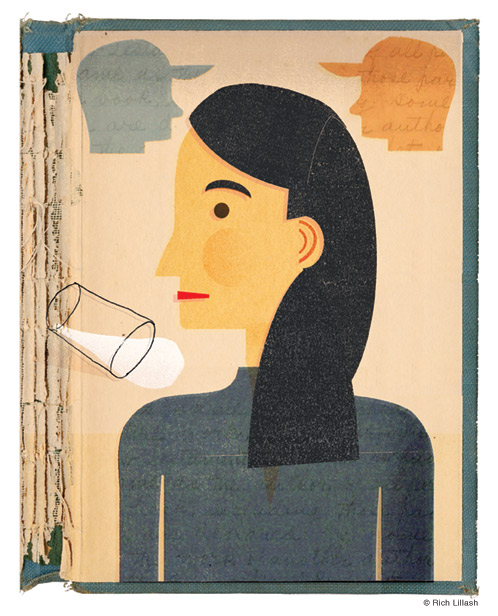
Courtney Zoffness C’00 is a fiction writer. It’s the form she studied at Penn and the one that led her through two master’s degrees. Fiction even won her £30,000 in an international short story contest, where her competitors included Curtis Sittenfeld and Miranda July.
So the fact that Zoffness’s debut book is a memoir-in-essays comes as a curveball, including to the author herself. “I should make clear that this book sort of came together by accident,” she says. “I was cheating on my fiction with what I thought were these one-offs. I didn’t realize I was actually writing a book.”
But now that book is scoring starred reviews (Publishers Weekly, Booklist, Book Page) and appearing on lists of the most anticipated titles of 2021 (Publishers Weekly again, Lit Hub, The Millions).
Spilt Milk (McSweeney’s Publishing, 2021) opens with anxiety—a familiar state for Zoffness, but one she’s just started to glimpse in her five-year-old son. As in most of the book’s essays, she glides between time and space with ease, in this case building to a subtle examination of nature versus nurture. Could her son be exhibiting anxiety because of the genes she passed on, because of her parenting, or because, as she writes, “I am both his nature and his nurture”?
Further meditations on motherhood flow throughout the book, as Zoffness writes in lyrical prose about her own complicated mom; her friend’s role as a gestational surrogate; and navigating her four-year-old’s worshipful obsession with police officers at the same time the Black Lives Matter movement is accelerating. That and the surrogacy essay are the ones she’s most proud of in the book, she says, because they didn’t shy away from complexity.
As she writes in “Boy in Blue,” her young son had noticed something while monitoring the NYC precinct station on their street every day:
Most people we see in handcuffs, he says, have brown skin. He holds my gaze, scans it for something. Opinion. Emotion. He wants to know what this means, how to feel about it.
They do, I say, gut seizing. I sustain wide eye contact, an attempt to buy time. I think, This is how the association coalesces: the good/bad with the cop/criminal with the white/brown.
I mutter something about how Black and Latinx folks make up less than a third of the population but more than half of those imprisoned. That criminality and law enforcement are complicated, that people with white skin break just as many laws. Everything feels inadequate. Opaque.
Zoffness isn’t interested in coming off as a mom who has all the answers in Spilt Milk—or even “the most lovable and perfect person,” she says. “I certainly cop to my own shame and my own flaws” in these essays, “and I hope that makes me a more credible narrator.”
But what’s it like to reveal these pieces of yourself to readers whom you’ll never meet? To have them know so much about you? “They actually don’t know that much about me,” she says. “They certainly know the stories that I’ve shared, but this is a carefully curated book.”
If you’ve only read Spilt Milk, you won’t know, for instance,that Zoffness grew up in Westchester, New York, where she used to write her own songs and plays and perform them. You won’t read about the thrill she got from binding her own book in fourth grade, the poetry contest she won in high school, or how she drew editorial cartoons at Penn for the Daily Pennsylvanian.
You will, however, learn about her first panic attack, suffered in the bathroom of Penn’s fine arts building during a Drawing II class. “I held the stall walls as my breath thrashed and the world galloped and the tiles trembled under my feet,” she writes. “I sweated through a pair of overalls. My teeth chattered all the way home.”
You won’t read about the A+ she landed for an advanced fiction workshop her senior year at Penn, though it was a landmark moment in her becoming-a-writer journey. “I literally wept,” she says. “I didn’t even know you could get an A+.”
Zoffness counts herself among the founding members of Kelly Writers House, which formed during her Penn years. She hosted “Speakeasy” open mics there—a series that’s still running today. Though she never presented her own work, she knew she’d keep writing after graduation.
At first she became a journalist, working for MTV Networks’ internal magazine. When her journalism “kept getting more and more creative,” she sent in a rant from her personal journal and was accepted to Johns Hopkins’ Writing Seminars. “Once enrolled, I couldn’t replicate what I’d done, nor could I explain why it had satisfied,” Zoffness remembers in a Spilt Milk essay. “I spent the next six months working backward, taking stories apart, sorting out mechanics. The process was deflating. Painful.”
But along the way she discovered writers like Lorrie Moore, who showed her that “you’re allowed to be really funny and dark and very female in your writing,” she says. She also began to find a balance between lyricism and narration. “Early on, my stories were either melodramatic and not beautiful, or like prose poetry where nothing happened,” she says.
By the time she’d finished a second master’s at the University of Arizona and returned to teach writing classes at Penn, Zoffness’s stories were getting published and reaching the final rounds of prominent fiction competitions. In 2012, she began teaching at Drew University, where she’s now the director of creative writing.
The “biggest literary highlight of my life,” at least so far, arrived in 2018, when she won the Sunday Times Short Story Award—a British competition launched in 2010. Aside from bestowing £30,000, the prize placed her in the company of past winners, including Pulitzer Prize alums Junot Diaz and Anthony Doerr. “I remain the only winner of that prize who didn’t already have a published book,” she says.
In Zoffness’s winning entry, “Peanuts Aren’t Nuts,” you’ll find shades of “Hot for Teacher”—the second essay in Spilt Milk. Through different framing, both dig into the experience of being a woman, the object of male desire, and the sometimes-blurry lines between creepy behavior, inappropriate advances, and assault.
Like some of her other work, “Peanuts” teeters between funny and tragic, occasionally hitting both keys at the same time. “I think those are my favorite registers to inhabit in both genres,” she says. “I try to be in all those places at once because that, to me, feels like life.”
Though she’s been tinkering with personal essays for over two decades now, the ones in Spilt Milk all come from the past several years. “For the most part, these pieces were written as I became a mother and was seeing all things in new ways,” she says. “Something would happen, and I would want to capture it and comment on it and question it. And the essay form really facilitated my ability to do that.”
Still, “fiction is my first love,” she says. She’s working on several fiction projects at the moment while also teaching, book promoting (her spring calendar is stuffed with events, including a—virtual—return to the Kelly Writers House in May) and raising her two young sons. But when COVID-19 invaded her home earlier this year, asymptomatically infecting both of her kids, it was the personal narrative to which Zoffness returned once again. Another meditation, this time on motherhood in the time of coronavirus.
Here she is, writing in the New York Times about the experience. She and her husband are in-home quarantining their asthmatic younger son, in an attempt to stop his virus from ripping through their family. But now he’s just called for her:
“Your highness?” I say, poking my covered face inside. He is upright on his bed, hair mussed. He stares at me. Then he opens his arms wide.
There is a flicker of panic in his face, a question mark, that I won’t approach. Or maybe I’m projecting; for a blink, I hesitate. I worry he sees this. I am afraid of my own child.
I can’t promise that I exuded calm in the moment my youngest reached out to me, as much as I wanted to. Tried to, Zoffness confesses a few paragraphs later. But what I could supply, without pretense, was comfort. Love.
On his warm bed, my son and I wrapped our arms around each other tight and did not speak a word.
—Molly Petrilla C’06
Beheld
On the search for selfhood.
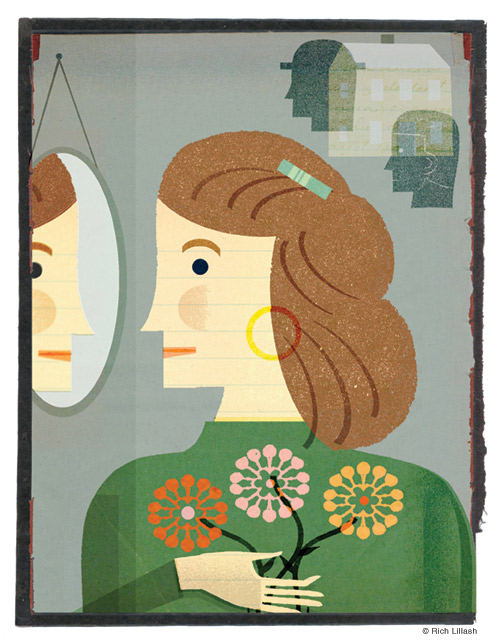
In 2015, better than a decade deep in the thickets of midlife, Beth Kephart C’82 woke up bewitched by a painter who’d been dead for 18 years. But that sentence harbors a double imprecision. The spell may have fallen at midnight, not morning. And bewitched is a freighted word to pin on a woman of any age, much less a formidably lettered one now tending an emptied nest. Maybe entranced comes closer to the truth, or captivated, or mesmerized.
Or possessed.
“I called her by her apostrophes,” Kephart writes of Henriette Wyeth: “N. C. Wyeth’s daughter. Andrew Wyeth’s sister. Joseph Hergesheimer’s extra-marital squeeze. Peter Hurd’s wife. F. Scott Fitzgerald’s neighbor. Paul Horgan’s friend. Peter’s and Ann Carol’s and Michael’s mother. I called her like this because I called myself the same. Father’s daughter. Husband’s wife. Son’s mother. And only after that, for both of us: artist.”
For Kephart—the author of more than 30 books spanning half a dozen genres—Henriette held out a tantalizing possibility: “finding myself inside another self, learning myself through her.”
Chased over three thousand miles and how many canvases and letters and through a dozen drafts, Henriette Wyeth would prove elusive. “I’ll be the only one I find,” Kephart concluded. But by the end of Wife | Daughter | Self (Forest Avenue Press, 2021)—in which Henriette rears up in a single essay among many—it is hard to be so sure.
Early in this triptych essay collection Kephart hears her husband say “Happy anniversary” and looks up from the pages of Michael Ondaatje. “Is this how we discover the truth, evolve?” that genre-shattering writer asks. “By gathering together unconfirmed fragments?”
That is the mode of this stealthily provocative work, which begins with Kephart’s incarnation as Bill’s Wife. “We are not Zelda and F. Scott. We are not Georgia and Alfred, Frieda and Diego,” Kephart declares, aiming less to telegraph humility than the deeper intention of this book. Some memoirs—most—recount a life, often an extraordinary one. This one examines life, unnarrowed by the singular article. It is a more intimate and ambitious undertaking.
Bill is a visual artist—a photographer and potter and illustrator whose woodcut-style monochromes grace the pages of this volume. A sinewy Salvadoran whose mother tongue remains foreign to Beth, who sometimes talks and sometimes doesn’t, who travels in solitude and might contentedly forsake their suburban home forever tomorrow afternoon, he is painted in this memoir as something akin to the author’s photographic negative: a kind of reverse image inextricably tethered to its companion. But Kephart’s essays delineate more than the contrasts and congruencies that comprise their marriage—that make up any marriage. It is the transformations that she’s after. Holding a vase he has potted, inspecting a photograph he has taken, “I learn more about my own seeing. I change the conversation that I am having not just with him, but with myself.”
Kephart can summon visions of herself with vivid detail. Kayaking across a smooth-topped lake on a puff-sky day, the yellow blades of her paddles are dragonfly wings, and her biceps prettily swell. But back at the dock she needs Bill’s help to hoist the shell from the water—and it is not her own view of herself that intrigues her, but his. In “the glow of an abjectly dubbed TV show” he turns to look at her and she cannot imagine what he sees. “I kept watching the show; my husband kept watching me. What do you see? I wanted to ask him, but no translation is a good translation,” she writes.
“What do you see?” she asks herself again, and here exposes her real plea: “As if my husband might do the work of knowing me.”
As Daughter, Kephart primarily filters herself through the lens of her aging father. Helping him sell the house where he raised their family. Helping him through the pages of photograph albums: Thanksgiving in the Luray Caverns; a Shenandoah overlook; Graduation Day, June 1952, University of Pennsylvania. Helping him through the throes of ICU delirium. The caregiving in these pages is rendered with a tenderness to sting the eyes of any child who has carried a parent’s burden, and it is eloquent with emotional insight. Yet something unsettling lurks in the depths. After untold days at her father’s bedside, after miles conducting nostalgic car rides in the Volvo he can no longer drive, after bringing him to see hot-air balloons in colors beyond counting float breeze-ward “like musical notes, like a harmony sung only in soprano,” he tells her: Go. It is time that she come see him less. He wants time alone: “time,” as she interprets it, “to harbor and protect his secrets.”
And here the dilemma swings open like a trap door, for if so much of what we are is determined by what we are to others—not just how they see us, but how we understand the selves that emerge from our relationships with them—then who are we in their absence? This is a universal question, but also, in this volume, a gendered one. Because Kephart, like so many women, has woven her life into those of “two men, my husband and my father, who—most of the time in normal circumstances—are most comfortable alone.”
So the book’s third section, Self, is especially compelling. Delving into her adolescence, Kephart exhumes an early attempt at an answer: lying. After a childhood in the thrall of being “good” or even “perfect,” lies became a means to conjure up charisma and attract attention. Lying about the intensity of a schoolboy’s affection. Lying about how many hours she could keep a Hula-Hoop from falling off her waist. Lying actual fish stories, shifting her sister’s catch to her own hook. Lying, eventually, on the page—in poems, in fiction. Yet some lies that are easy to tell turn out to be less easy to live with. She looks in the mirror and discovers that “the lies are changing, the lies are changing you.”
Where then does her true self lie? As an undergraduate humiliated by peers ridiculing her poetry, Kephart retreats into “history, calculus, biology, economics, law, accounting.” Writing a thesis on the dawn of engineering schools, she takes stock of herself: “You don’t know who you are.”
She chases an answer in Henriette Wyeth—a standout essay—but is the self revealed by that journey any more definitive? The revelation of the Self section is the impossibility it presents. The harder Kephart presses inward toward herself, the more implacably her father and husband and son and mother come seeping in through the cracks. In every self there is “an infinitude,” she concludes.
But are any of them truly and purely our own? That question—which Kephart does not spell out but purposefully skates around, inscribing it into the ice—beats at the heart of this elegant and evocative inquisition. As for answers, those are plural. But surely there is significance that the final essay culminates with Kephart frozen in the doorway of her mother’s hospital room, resplendent in precisely the kind of red dress she never wore but which her mother found beautiful, standing still to elongate her mother’s pleasure and her own: “not moving, not breaking the illusion of my temporary self.”
—Trey Popp
Life’s Call
“An aging man still in love with words and a handful of people.”
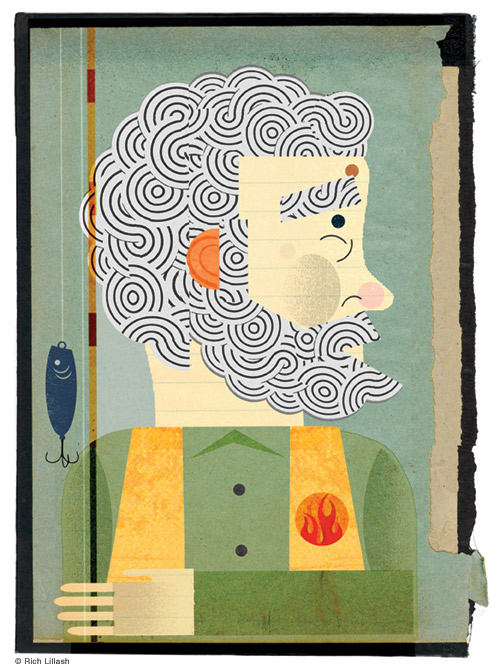
There’s a problem with the subtitle of Nick Lyons W’53’s memoir, Fire in the Straw: Notes on Inventing a Life (Arcade, 2020). It really should be Lives, plural.
In his going-on-90 years, Lyons has tried on—no, inhabited fully; he’s not one to do things by halves—multiple identities: teacher, editor, entrepreneur, writer, lover of literature (all the more ardent for coming late to his passion), and (lifelong) fishing enthusiast. This brief but packed book finds room for all of them—plus his experiences as a student (fitful, then obsessed), soldier (a fruitful “buffer zone”), and basketball player (better than he should have been).
As a writer, Lyons is best known for his “piscatorial” essays in books like The Seasonable Angler and A Flyfisher’s World, and readers who only know him from that genre may be unprepared for the breadth and darkness in Fire in the Straw. He eloquently describes what fishing has meant to him from childhood: “Always, somehow, wherever I was and whatever I did, I leaned like a magnet to the numinous world of water, hungry for the mystery beneath the surface, the electric jolt when a fish takes the bait, a bobber dips under, the line tugs.”
The book begins with a betrayal, when five-year-old Nicki is taken from the “labyrinthine apartment” in the Bronx he shares with two bachelor uncles, his grandparents, and his widowed mother and abandoned at a boarding school. It was a “perfectly decent place,” not something “out of Dickens,” he writes, but still scarring. It teaches him a general reserve, and leaves him with a permanent distance from and distrust of his mother: “I spoke to her increasingly with more caution and care and began to live more and more in the cave of my own brain.”
(Many years later, in a harrowing passage that is one of the book’s strongest, he writes of keeping vigil over his mother’s dead body while waiting for the medical examiner to show up days after she had died suddenly in her apartment, his ruminations on their relationship interrupted by gruesome details about the growing stench and the difficulty of getting her stiffened corpse out of the bathroom.)
After his mother remarries, to a man named Arthur Lyons who wants to adopt him, Nicki balks at first, but agrees, thinking the alternative is a return to boarding school, “that mausoleum.” It’s Arthur who will eventually encourage him to go to Wharton, where he makes a few friends and gets to play alongside the great Ernie Beck W’53, but doesn’t take away much else. (He calls—unavailingly—on the memory of Beck in a later chapter about the end of his basketball days limping home from a city hoops court.)
Time in the army, stationed at a miserable but Paris-adjacent military outpost in France, turns out to be a pivot point, awakening a powerful desire in him to read and write. Reading Lyons’ account of coming alive to literature is to truly understand the concept of a “voracious” reader. “Now I could not study hard enough, reading with the same thought that this was a meal for my brain, something I needed to live.” And he goes at writing with the same furious energy, renting a tiny room in Greenwich Village, where he alternates long solitary walks through the city with marathon stints at the typewriter—though little comes of the effort at that point.
But a class at the New School, where a life-changing teacher tells him, “Remember. You’re not dumb, Nicki. You’re just illiterate,” leads him to Bard College, then graduate school at the University of Michigan, and life as a literary man. In “Some Woodstock Summers,” a version of which appeared in the Gazette [“Alumni Voices,” May|Jun 2020], Lyons describes how, after laboring over fiction, poetry, and academic writing, it was by way of a fishing story that he hit on the prose style—“earthy, nimble, wry, full of wit and worms and celebration”—that would serve him in hundreds of essays and more than 20 books written or edited.
After graduate school, Lyons took a job at Hunter College, where he taught for close to 30 years. He is modest about his professorial career (“My only academic gift—a minor, narrow one—was a flair for taking this literature that I loved, which I knew had transformed my life and might transform other lives, and sharing it enthusiastically with others”) and mordant in his description of campus politics and academic snobbery.
For a good chunk of that time, to make ends meet, he also worked in book publishing, and eventually became executive editor at a major house. When a tenure committee he chaired at Hunter is arbitrarily overruled, it comes across as a welcome escape hatch to set out on his next endeavor, building on his editorial contacts and experience, as the founder and publisher of what became the Lyons Press.
In financial terms, this seems like jumping from the frying pan—or the tepid-but-slowly-boiling academic pot—into the fire, but Lyons managed to both survive and put out work of which he is justly proud (though chagrined at bigger publishers stealing his authors). He’s also bracingly honest about the near-constant financial struggles involved in keeping his business afloat and providing for his family while staying a half-step ahead of creditors along the way.
Toward the end of the book, there’s a lovely idyllic period after Lyons sells the press in which he and his beloved wife, the painter Mari Lyons, are able to concentrate on their respective arts, and to travel “every year to Paris, Madrid, Venice, Florence, and walked everywhere and spent long days in the great museums,” and he “managed to fish intently again.” It’s cut short by her death from cancer, soon after their 58th wedding anniversary. “She had given me life. She had been my life,” he writes.
But despite his losses—including the death of one of his four children—life still calls to him. Sorting through Mari’s studio, his face is suddenly reflected in some darkened glass: “I see a runneled face, an aging man still in love with words and a handful of people, still with much work to do, important to him. The old fire I found in me, that sustained me, is banked low, but the orange coals are bright.”
—John Prendergast



